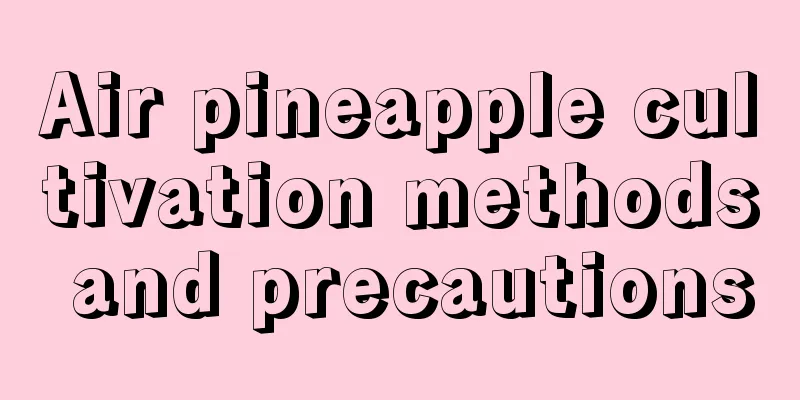Which month is the best to plant watermelons?

|
Watermelon is a very popular summer fruit. Although it is sweet, it is relatively low in calories. Watermelon is widely grown around the world and is an important economic crop in many regions. So which month is the best to plant watermelons? Which month is the best to plant watermelons? The timing of watermelon sowing depends on the characteristics of the variety and temperature conditions. 1. According to different watermelon varieties If you want to harvest early-maturing varieties that can be marketed in early July, you should generally start sowing in mid-to-late March. Medium and late maturing varieties that are expected to be harvested from the end of July to mid-to-early August are suitable for sowing in mid-to-late April. For autumn watermelons harvested in September and October, the sowing period is from the end of June to mid-July. 2. Consider the impact of temperature on watermelon sowing Watermelon prefers high temperature environment and is not resistant to low temperature. Its seeds need a temperature of at least 15°C to germinate (the most suitable germination temperature is 25-28°C). The root system of watermelon needs a temperature of at least 15°C for growth, at least 22°C for the seedling stage, and at least 25°C for the flowering and fruiting stage. It also needs a large temperature difference between day and night to accumulate sugar. Therefore, the earliest time for spring watermelon sowing should be when the soil temperature reaches above 15°C, which is the minimum temperature requirement for seed germination. However, in order to ensure that the watermelons can emerge quickly and evenly, it is recommended to sow when the soil temperature rises to above 18-20℃, which is more conducive to the growth of watermelons. Preparation and field management before watermelon planting 1. Land preparation and ridge making About 15 days before planting watermelons, the land needs to be prepared and ridged to create suitable soil moisture. For greenhouse watermelons, it is recommended to use the high-ridge double-row cultivation method, with a large row spacing of 90 cm and a small row spacing of 40 cm, building a small high embankment with a ridge width of 30 cm and a ridge height of 15 cm. After the bed surface is prepared, cover it with ground film immediately in preparation for planting. For watermelon cultivation in greenhouses, a plastic greenhouse should be built before land preparation. The inner diameter of the greenhouse should be no less than 6.5 meters and the height should be no less than 1.6 meters. The width of the small arch in the middle should be 2.2 meters and the height should be 0.7 meters. The thickness of the straw thatch should be no less than 5 centimeters. For watermelons grown in greenhouses, the bed surface should be prepared and covered with mulch 6-7 days before planting. 2. Field management (1) Temperature control The temperature should be maintained at 25-30℃ during the day and not lower than 15℃ at night. If the daytime temperature exceeds 30°C, ventilation is required. After flowering, the temperature can be appropriately raised, maintaining 28-32℃ during the day and not lower than 15-18℃ at night. The temperature difference between day and night is most suitable at 10-15℃. (2) Humidity control The growth of watermelon stems and leaves requires lower air humidity, and the relative humidity should be controlled at around 60%. The humidity needs to be increased to 70-75% during flowering and pollination. Cover the ground with film to reduce water evaporation and keep ventilation. Ventilate after each watering to reduce humidity. (3) Fertilizer and water management Watermelon absorbs different amounts of nitrogen, phosphorus and potassium during different growth periods. The absorption amount during the seedling emergence stage accounts for 0.01% of the entire growth period, 0.54% during the seedling stage, 14.6% during the vine extension and flowering stage, and 84.85% during the fruiting stage. Therefore, fertilization should be adjusted according to the growth period of watermelon. Generally, top dressing is done three times after transplanting: the first time is after the seedlings have grown, with 1 kg of 0.3%-0.5% urea water poured into each hole; the second time is when the vines are about 30 cm long, with 5-8 kg of decomposed cake fertilizer or triple compound fertilizer per mu; the third time is after fruit setting, with 30 kg of triple compound fertilizer per mu and 10-15 kg of potassium sulfate. During the fruit expansion period, spray fertilizer on the leaves 1-2 times, using 0.3%-0.4% potassium dihydrogen phosphate and 0.4% urea solution. Watering should be properly controlled, and the amount of watering should be increased after fruit setting. (4) Chemical weed control Due to the large area of watermelon fields, manual weeding is rather cumbersome. Experiments show that spraying the soil to seal it before covering the film and using herbicides such as fluazifop, dole, dimethoate, and cypermethrin are more effective. 3. Pest and disease control Disease prevention and control: The main diseases of watermelon include damping-off, damping-off, wilt, powdery mildew, anthracnose, etc. For damping-off and damping-off diseases, you can use carbendazim and Green Heng No. 1 to disinfect the seedbed; for wilt disease, you can use 15% watermelon continuous cropping agent No. 1 300-350 times diluted to irrigate the roots, 0.5 kg each time, and use the medicine when there are 3-4 true leaves after transplanting; powdery mildew and anthracnose can be controlled with drugs such as thiophanate-methyl, thiophanate-methyl, and triadimefon, which can be used alternately. Pest control: The main pests of watermelon include stink bugs, aphids, ladybugs, root maggots, red spiders, etc. The control agents can be selected from avermectin, dichlorvos, and diazinon alternately, and the root maggots can be treated by root irrigation with trichlorfon. It is recommended to use insecticidal lamps and yellow board traps for physical control. Root-knot nematodes cause great harm to plants during the seedling stage, so the seedbed should be selected in a plot without root-knot nematodes. If nematodes are found, you can use avermectins such as 2000 times diluted 1% mite cleaner or 3000 times diluted 1.8% abadin to irrigate the roots. When preparing the field, you can choose to apply pesticides such as phoxim, miral, carbosulfan, diazinon, and chlorpyrifos. 4. Storage conditions Watermelon likes heat and is afraid of cold. It has a large body and thick skin, but is not resistant to storage. It is sensitive to low temperatures and will show cold symptoms when stored below 9.5°C; the sugar content will decrease and it will easily rot when stored at high temperatures. The above is an introduction to the sowing time and planting points of watermelon. When planting watermelon, everyone should pay attention to these points. Moreover, not all regions in my country are suitable for growing watermelon.
|
<<: When to transplant onions?
>>: How many days does it take for lettuce to sprout?
Recommend
What is the difference between Asparagus and Ophiopogon japonicus
1. Different families Asparagus: It is a plant be...
How to keep camphor trees warm in winter?
In recent years, the safe wintering of camphor tr...
The growing environment and local conditions of sugar beets
Beet growing environment and conditions Beet pref...
How to propagate cinnabar root and precautions
Cinnabar root propagation method There are two wa...
How often should you water violets?
How often should you water violets? Violets like ...
How to grow trumpet creeper in winter
Although trumpet creeper is easy to maintain, all...
The efficacy and function of Yacon
1. Reduce heat and detoxify Yacon can speed up th...
What flowers are suitable for growing in Linxia? What are the city flowers and trees?
1. Climate characteristics of Linxia Linxia Hui A...
What to do if the leaves of crystal palm become soft
The main reason why crystal palm leaves become so...
How to plant lotus seeds
Time to plant lotus seeds Bowl lotus is usually p...
When is the gardenia blooming?
1. Flowering Season Gardenia blooms in spring and...
I have a yard like this, I won't sell it even if you give me 10 million
First is Huahua’s favorite rose! It is also made ...
How to grow morning glory
1. Maintenance methods 1. Temperature: Morning gl...
How to change the pot of peacock ball
1. Time Selection The plant needs to be repotted ...
The difference between Aloe Vera and Aloe Vera
1. Leaf Difference The leaves of the Aloe Vera ar...









